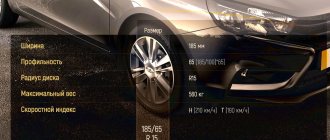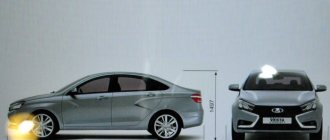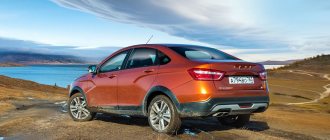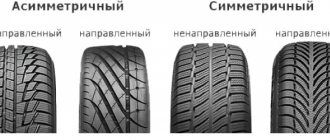In 2022, 13 Lada models with increased cross-country ability will be produced. Lada XRay and all Cross variants have a ground clearance above 190 mm. Real SUVs include the 4x4 family (Niva), which includes the Chevrolet NIVA. The official website offers concepts with a focus on off-road driving. In December 2019, the first renderings of the Lada Vesta jeep were leaked onto the Internet. According to the concern, the Lada Vesta SUV will not be inferior to the Niva in cross-country ability, providing the comfort of a family car.
SUV Lada: Xray Russian crossover
So, it is coming - the first and only crossover of the Russian modern automotive industry - the Lada Xray SUV. For the first time, this car was presented to the world community at the Moscow Motor Show, where it created a real sensation. This was to be expected, because the inspiration for the design of the car was none other than Steve Mattin, who collaborated with such auto industry giants as Mercedes and Volvo.
AvtoVAZ presented the new SUV Lada Xray as the first sign of a new direction in Russian auto production. Why the designers chose the SUV class for their innovations is explained very simply - it is this segment of cars that has been in greatest demand among the population over the past 5-10 years. First test drives of XRay.
The design and technical characteristics of the Russian jeep are aimed at young and energetic people who do not like to sit still and dream of visiting all the remote corners of their country and the whole world.
Design and interior decoration of Lada Xray
The interior of the SUV is designed for 4 people - that’s how many individual seats fit in the car. An interesting feature of the car is the panoramic roof. The dashboard is made ergonomically, it has a digital display for monitoring important parameters of the car, the display of the multimedia system can be easily folded and will not interfere during complex maneuvers. By the way, the AvtoVAZ emblem on the car’s radiator grill has increased significantly in size.
It is not clear why the controls are in English, but perhaps this is a hint at entering the global car market?
The new Lada SUV attracts attention with high-quality and high-level equipment - navigation, communication control, multimedia center. The only thing that confuses us is the manufacturers’ statement that the production car will be slightly different from the one presented at the Auto Show: there will be fewer options in the cabin, and the “zipper” located on the doorway will disappear.
SUV Lada - technical specifications
Due to the fact that negotiations are underway on the sale of AvtoVAZ to the Renault-Nissan concern, the exact characteristics of the new crossover are not known. The fact is that it was planned to use new developments by Russian designers to complete this car. If AvtoVAZ comes under the wing of the French-Japanese alliance, the new owners can use their developments. The estimated release date of the Lada SUV is 2016.
It is tentatively planned to install 2 gasoline engines on the Lada SUV - 1.6 liters and 2.0 liters, each of which will have 4 cylinders. The engine volume of 1.6 liters will be 1598 cm3, and that of 2.0 liters will be 1997 cm3. Power is 117 horsepower and 141 hp, respectively. With.
The car will be produced in all-wheel drive and front-wheel drive versions.
Fuel consumption will depend on the type of drive and ranges from 8.1 – 10.8 l/100 km. The maximum speed (188-194 km/h) and acceleration of the crossover - 9.5-12.0 s to 100 km - also depend on the drive.
In one of the press releases, the designers stated that they, together with their British colleagues, are developing another engine - a 1.8 liter one.
Without knowing the exact characteristics of the Lada SUV, it is difficult to guess the cost of this car. If we take the engines described above and the minimum interior equipment as a basis, then we can assume that the price of the Lada Xray will fluctuate between 500-600 thousand rubles. When fully equipped, this car can cost 1,200,000 - 1,500,000 rubles.
"Lada" SUV class
Among the cars that came off the assembly line of the AvtoVAZ concern, only representatives of the 4x4 family are considered full-fledged SUVs.
Interior
The restyled Nivas received a dashboard based on the Grants console. Against its background, the steering wheel seems huge. The interior elements do not fit together perfectly, there is play in the deflector handles, and the fans make a lot of noise. The back row is very crowded; this problem has been carried over from the very first car of the family.
Chevrolet NIVA plastic is also from the cheap segment. The design was worked out more carefully, but was outdated 20 years ago. The sound insulation is better than that of the mother model, and there is a little more space in the rear seats.
Exterior
All representatives of the Niva family have common appearance features. The car almost completely repeats the style of the very first model, released in 1977. Round headlights, square body - it’s not difficult to identify a representative of the family, be it a Soviet-made product or modern 3 and 5-door cars.
LADA Vesta SUV. Photo source: https://zen.yandex.ru/media/id/5c332e321db07f00abad5973/vesta-suv-polnorazmernyi-vnedorojnik-lada-5defe8fbc7e50c00b1e24dd3
Niva-Chevrolet did not copy its parent and got its own image. The appearance of the car is not pretentious. The body shape embodies the classic SUV design. There is a plastic body kit.
Specifications
A 5-speed manual transmission is offered for the entire Niv family. Engine capacity is 1.7 liters, rated speed is 137-142 km/h. One of the disadvantages of the car is its gluttony: 12.1 liters are consumed per 100 km in the city. The model produced with the Chevrolet logo has the same engine. There are examples of Chevrolet NIVA with diesel engines.
“Nivas,” which occupy the segment of cheap jeeps, are equipped with power steering, air conditioning, electric windows, and a heated mirror system.
Competitors
Considering the price of the new Niva (from 510 thousand rubles), finding its competitors is not so easy. Lada 4x4 is a real budget off-road conqueror. Other legendary representatives of the SUV class are significantly more expensive:
- Toyota RAV4 (from 1.8 million rubles). Drive control is almost completely transferred to electronics, and it does its job well. The heterogeneous geometry of the car forces the driver to be more careful when planning an off-road route: there is a high chance of the muffler getting caught and torn off.
- Toyota Land Cruiser 200 (from 5 million rubles). Kruzak 200 requires attention. The car is reliable if the driver does not forget to carry out maintenance. The weak point is the brakes. Discs and pads wear out quickly, since the car weighs 2.5 tons.
- Land Rover Defender (discontinued 2016). The Defender was spotted on the top of Elbrus and on the ice crossing across the Bering Strait, which perfectly illustrates its maneuverability. Owners note the car's tendency to skid. The vehicle is not designed to overcome water obstacles. The generator on the engine is located low, and high humidity is critical for it. Another serious disadvantage is that the first problems begin to appear after 60 thousand kilometers (oil leaks through the seals, electrical problems). But we must give the Defender its due; breakdowns leading to loss of mobility are extremely rare.
- UAZ-469 (UAZ-3151). Production ceased in 2015. UAZ is easy to operate and repair. Almost any problem can be easily fixed on the go. On the downside, there is always something to fix in this car; breakdowns often occur on their own, even with a car parked in a garage.
- Mercedes-Benz W463 (the last copy rolled off the assembly line in 2018). A passable car with good handling. Weak spots susceptible to rust: welds, rear fender joints, door hinges, trunk edges.
- Nissan Patrol (from 4.5 million rubles). The Japanese thoroughly thought through the safety of the Patrol. According to many drivers, after serious accidents, the car is written off, while people escape with minor injuries. One of the elements that ensures safety is a rigid suspension. At the same time, this advantage seems to be a disadvantage - on an uneven road you can feel every bump. Even replacing the shock absorbers doesn't help.
- Toyota Land Cruiser 80 (production completed in 1997). The suspension and engine of a car are considered the standard of reliability. Fuel consumption in the city per 100 km is about 20 liters, which does not allow the car to be called economical. The weight is almost three tons, which makes it easy to overcome obstacles in the form of shallow rivers, but in the case of a “deep landing” it is difficult to pull the car out.
The price gap does not allow these cars to be considered complete analogues of the Lada 4x4.
What a large LADA SUV could be like
Currently, there is only one SUV in the LADA model range - the classic Niva (LADA 4x4). AVTOVAZ does not yet have a large all-wheel drive SUV, so research on the topic has to be carried out by amateurs. Russian designer Alexander Storm shared with Gazeta.Ru his vision of such a car under the Lada brand. What Lada might look like in XXL size:
The 3D model has an X-shaped style. At the front, the LADA SUV inherited features from the Lada XRAY crossover. There are X-shaped stampings on the sidewalls, and the rear of the car strongly resembles the Lada Vesta model.
Let us remind you that at the upcoming Moscow Motor Show, which will open at the end of August 2022, AVTOVAZ is preparing several surprises. It is expected that at the exhibition the company will show two new crossovers and a new generation of Lada 4×4.
Share on social networks:
Found an error? Select it and press Ctrl+Enter..
Source
Dreams about something more: the history of all-wheel drive on a VAZ
Genes and engineers
No, the Niva is a cool car, we are not going to argue with that.
We have already covered in detail the history of this machine, as well as its unique floating incarnation, the River, we are closely monitoring the progress of modernization of the current generation and are even trying to indicate what the next generation will be like. However, Lada 4×4 New Generation (the working name of AVTOVAZ’s new SUV) is still very far from reality and, in fact, little definite can be said about it. And the current generation of Lada 4×4 remains the only option for using all-wheel drive on Lada brand vehicles. This is exactly how things have been for almost 40 years. Although this is only true for mass-produced products - nothing really came off the assembly line in Tolyatti with all-wheel drive except the Niva in all these years - except for the small-scale VAZ-2120 Nadezhda minivan, built on the Niva platform. However, the Niva, with all its advantages and once revolutionary concept, quickly ceased to be a “comprehensive” jeep (and was it even such?), satisfying all needs - Nadezhda is just one confirmation of this.
Articles / History Team Europe: how the West took part in the creation of the VAZ-2108 We have already talked about the fact that the German company Porsche took part in the creation of the first Togliatti front-wheel drive car. However, this is all “help from the West” and its presence in the so-called... 17669 8 11 11/22/2015
All this time, the engineers were dreaming of something more. Our story today will be about these attempts to instill all-wheel drive genes in Lada.
For the first time, it occurred to Togliatti athletes to make an all-wheel drive car, but not a Niva - before the eighties had time to jump over the equator, and the G-8 had become a production car, VAZ rally drivers had already assembled an all-wheel drive prototype with a VAZ-2108 body and a central engine. Of course, “Niva” components - in particular, the transfer case - were used in that car, where would we be without them. It was an extreme racing option, but the idea of using Niva’s “genes” in a “chisel” was returned a dozen years later - however, the concept was completely different, closer to “civilian” vehicles... Well, it’s time to let our monsters out of the cage.
Monster #1. Tarzan
The concept of the VAZ-21083-34 Tarzan was born at the AVTOVAZ Scientific and Technical Center, but in 1996, when the first publications about the car began, the author of the design, Sergei Taranov, was called “a Tolyatti resident, currently not associated with the Volzhsky Automobile Plant.” The partner responsible for the body design was the DeCon company, and the finished product was produced by the Lada-Consul enterprise, but “with the participation” of the AVTOVAZ Pilot Industrial Production. The car turned out to be interesting, and we have already told the story of Tarzan in detail, so here we will only repeat the main points and add some previously unexplained details.
The body of a front-wheel drive VAZ car (at first VAZ-21083, and later -2111 and -2112) in Tarzana ceased to be a load-bearing structural element and was mounted on an original frame made of a rectangular profile of variable cross-section. In addition to the body, two front axles from the Niva were screwed to this frame.
One was placed in front, and was driven from a standard Nivov transfer case, which, in turn, was connected to a standard longitudinally mounted Nivov power unit. The second front axle of the Niva, rotated 180 degrees, was installed at the rear and “joined” to the transfer case via a cardan drive. This resulted in a frame SUV with independent suspension and all-round disc brakes, with maximum use of standard components and assemblies.
1 / 6
2 / 6
3 / 6
4 / 6
5 / 6
6 / 6
Articles / History Delight, disgust and off-road - the difficult path of the Lada Tarzan In the “dashing nineties”, many interesting projects were made based on VAZ models, most of which were destined to remain only projects. Convertibles, landaulets, limousines - whatever... 24894 8 24 01/05/2016
The “underwear” sticking out from below (that is, the frame) was covered with a body kit: on the first Tarzans these were massive plastic bumpers and sills, and on the bodies of the “tenth” family they were replaced by a protection kit made of welded pipes. The interior replicated the interiors of front-wheel drive vehicles, with the exception of three transmission control levers inherited from the Niva.
Tarzans were made only to order, so during the entire production period (from 1997 to 2004) only about 600 cars of all modifications were assembled, including Tarzan-UTS for public utilities. Journalists who tested the car spoke very positively about it, noting its spectacular appearance, increased comfort compared to the Lada 4×4, and high cross-country ability.
There were also disadvantages: a high center of gravity, transmission noise and vibrations, the high complexity of repairs caused by the presence of the frame... As an alternative engine, the Tarzans were equipped with a Peugeot diesel engine with a power of only 75 hp. s., but with a high torque that cut off the studs of the standard Nivov gearbox, and the diesel engine itself had difficulties with repair due to rare spare parts... Tarzan remained a small-scale, rather even a piece product. A kind of bright, but strange hybrid, a side link in the evolution of VAZ technology. It's a pity - Tarzan definitely had potential.
Monster #2. Victoria
Around the same time as Tarzan, another version of the all-wheel drive “chisel” appeared in Togliatti, and also, as they say, non-factory. An office called “Metallic-Quatro” began installing transmissions from Volkswagen Golf Syncro on VAZ-21099 sedans. The first “civilian” model appeared in 1996, although the scheme using components from the all-wheel drive Golf Syncro had already been successfully tested by cross-country athletes for several years by that time.
1 / 3
2 / 3
3 / 3
All that was needed to transform the peaceful “nine-nine” into an all-wheel drive “rogue” was, in fact, the “carcass” of the source, donor units and two days of skilled labor.
The car became known under the names VAZ-21099 4x4 Victoria and Lada Victory.
During the transformation process, the VAZ-21099 was “implanted” with a power take-off gearbox (or bevel gearbox), a rear gearbox, a viscous coupling and a rear suspension on oblique arms from Syncro. The right front axle shaft of the “ninety-nine” was slightly shortened, the left one remained standard, and axle shafts from the Niva were used at the rear to transmit torque to the wheels. From the transfer case to the rear gearbox, the torque was transmitted using a chain “the right axle shaft of the VAZ-2108 – the intermediate shaft on elastic supports of the VAZ-2101 (roughly speaking, a piece of the “classic” cardan) – the left axle shaft of the VAZ-2108.”
With the “bourgeois” gearboxes and viscous coupling, all this equipment was connected with the help of CV joints from the G8 and Niva. The rear suspension, stabilizer and gearbox were placed on the original subframe, as a result of which the tank was moved back and increased to 60 liters, but the spare wheel niche disappeared from the trunk. It was for layout reasons that the developers chose a sedan with a longer rear end than the hatchback as a test of the pen.
|
|
A viscous coupling with silicone liquid, the viscosity of which depends on temperature, connected the “back” when the front wheels were slipping. Externally, the car was no different from the production car except for the “Victoria” and “4×4” nameplates, a spoiler on the trunk lid and 14-inch alloy wheels, but off-road and in high-speed turns it surprised onlookers and rare representatives of the writing fraternity. who managed to drive it. Pleasant “bonuses” for all-wheel drive were a forced engine, a gearbox with changed gear ratios, as well as optional “sports” suspension struts and a reinforced clutch basket...
There was only one problem with the Victoria: the price list for the conversion was $6,500, which almost doubled the price of the car compared to the original, and according to some estimates, real Victorias were sold for about $20,000. Despite all the awesomeness of the resulting device, they were willing to pay that much few. It is known that in addition to the VAZ-21099, Victoria was also assembled in the back of the VAZ-2112 and was even delivered to Europe, but the matter was limited to single copies.
Monster #3. Eleventh 4x4
By the end of the 1990s, it began to dawn on the inert depths of AVTOVAZ that this was “w-w” for a reason, and all-wheel drive “sub-Jeeps” were a global trend. In the end, enthusiastic engineers inside the plant managed to push through the all-wheel drive VAZ-2111 project. In 1999, information appeared about a station wagon assembled at AVTOVAZ according to a recipe similar to that described above: the rear suspension, rear gearbox and viscous coupling were from Golf Syncro, but the power take-off gearbox was its own.
In the photo: Lada 111 GTI 2.0 4×4 (21116-04) '2001
It immediately became clear that the recipe was good, but still expensive, and AVTOVAZ STC specialists began to consistently reduce the cost of the design, and quite successfully: they developed their own rear gearbox, and even an original double-lever on a separate subframe. Thus, only the GKN viscous coupling remained borrowed.
In addition, the developers “played” with ground clearance; on various prototypes of the all-wheel drive “Eleventh” it gave an increase from 10 to 20 mm over the standard value. The cars were equipped with various engines - there were “budget” options with 1.5-liter eight-valve engines, and charged versions with a two-liter 150-horsepower Opel X20XEV engine, like the VAZ-21106.
In the photo: Lada 111 GTI 2.0 4×4 (21116-04) '2001
At least a dozen prototypes were built, some of which participated in numerous exhibitions and car shows. Development lasted more than ten years, manufacturers worked on reducing the price of the car to $8,500 (which is only a third more expensive than the serial 2111) and developing an all-wheel drive modification in small-scale production.
In the photo: Lada 111 GTI 2.0 4×4 (21116-04) '2001
However, none of the versions of such a “civilian” all-terrain station wagon VAZ-2111 4x4 began to be produced. All-wheel drive at AVTOVAZ became the domain of the Forced Testing Department, which created the hurricane Lada 112 VK S2000 Rally, and even then not for long...
Monster #4. Kalina 4WD
Mid-2000s. Those were the years when at AVTOVAZ it was still possible to do something other than projects that had an unambiguous deadline and a date for launching into production. Therefore, despite the lack of obvious prospects, the project of a small-scale all-wheel drive station wagon continued to live. In 2007, at the Moscow Motor Show, AVTOVAZ presented a prototype of the Lada Kalina 4WD. The transmission of this car itself was presented as a separate exhibit - nothing fundamentally new, however, it did not represent anything.
The only serious difference from the previously mastered schemes was that the same GKN viscous coupling was not located at the rear axle, but approximately in the middle between the front and rear axles. An original power take-off gearbox was attached to the standard gearbox, the shaft from which transmitted torque to the viscous coupling, and then the exact same shaft transmitted it to a standard Nivov gearbox, installed together with the original double-wishbone suspension on a subframe. To accommodate the subframe, the engineers had to reshape the gas tank and move the spare wheel niche close to the rear bumper, but the option turned out to be successful and for a long time was considered the crown of evolution of all-wheel drive at AVTOVAZ.
Lada Kalina 4WD Experienced (1117) '2007
However, this car did not become mass-produced - the times of dreamers and enthusiasts at AVTOVAZ never came - rather, on the contrary, the Lada brand entered the era of pragmatism. Once again there was no money for an all-wheel drive station wagon, no matter how fans of the brand asked for it - the amount of alterations in any case turned out to be too great.
In 2014, AVTOVAZ launched a rather successful Kalina Cross car, which is currently equipped with a wide range of options and even a robotic gearbox, but, alas, only has front-wheel drive. The Kalina Cross (like its “sister”, the larger Largus Cross station wagon) does not have all-wheel drive versions and is not planned.
Monster #5. Autoproduct Cross
And therefore, it is not surprising that the topic of all-wheel drive again “flowed over” to private companies. This time, the troublemaker was the Togliatti company and its founder Alexander Baburin, who previously worked at AVTOVAZ under the supervision of chief designer Vladimir Guba (formerly a famous motorsports driver) and participated in the creation of all-wheel drive vehicles based on the “tenth” family and Kalina, described above. In 2014, Avtoprodukt presented to the public its vision of the Kalina Cross car, and almost simultaneously with the presentation of the factory model with the same name - to the public disapproval of AVTOVAZ officials.
1 / 5
2 / 5
3 / 5
4 / 5
5 / 5
The car from “Avtoprodukt” - unlike the “purely VAZ” one, was not a station wagon, but a hatch - it showed off at several local motorsport events, but made a splash throughout the entire Russian automotive community. Like the factory Kalina Cross, the Baburin car was single-wheel drive, but the front and rear suspensions (both McPherson) were mounted on subframes, and all the hardware was developed independently by Avtoprodukt.
The rear subframe was designed to accommodate all-wheel drive, and the creators announced the imminent construction of 4x4 versions. And the advantage compared to the “stock” one, which was noticeable even on a single-wheel drive car, was improved handling: due to the modified suspension kinematics, an anti-dive effect arose and stability in corners increased.
In the photo: In the photo: Lada Kalina Cross
As of 2016, Avtoproduct is alive and well, but it practically does not build all-wheel drive vehicles. We know for certain about one car (a Lada Kalina station wagon, even of the first generation) with an “Autoproduct” suspension and all-wheel drive, made according to an almost canonical recipe - using VW Golf Syncro units, as well as axle shafts and CV joints from VAZ front-wheel drive and Niva.
This car, as usual, became the property of Tolyatti athletes, because, in fact, it was built according to their order. Probably, such tuning, if desired, can be ordered by a “mere mortal”, but it will be a one-piece and expensive product. At the moment, it seems, there is neither a more or less formalized concept for reducing the cost of design, nor the capacity for small-scale production. And Avtoprodukt has clearly shifted the vector in development and production from all-wheel drive to handling - suspension kits are offered for order on the company's official website.
What's the result?
This whole story shows us at least two things. Firstly, all these years, some Lada buyers desperately wanted to get a car with cross-country ability close to an SUV or crossover, and with comfort different from the Niva. There was demand, and there was always supply, more or less successful, and often almost piecemeal.
Secondly, this proposal always came not from the car manufacturer, but from third-party companies, while AVTOVAZ for many years was only trying to launch a similar product. Obviously, there should be some kind of all-terrain vehicle with all-wheel drive in the Lada line, but for the Volzhsky Automobile Plant, at least as we have known it for the last twenty years, this is a very difficult task.
However, “the last twenty years” is not an entirely accurate expression, because we have been observing very serious changes at AVTOVAZ for more than two years now. Yes, there are plenty of problems, but one cannot help but notice that there has been a huge leap in the pace of development of new models and modifications of Lada.
It has been repeatedly stated that an all-wheel drive version will be offered on the Vesta or Xray models, and maybe on both at once. There is no clarity yet, but it is known that for Xray engineers considered two concepts, borrowed and their own, and work on all-wheel drive for Vesta was confirmed in April 2016.
In any case, it will be something that has nothing to do with the previous Lada front-wheel drive vehicles and the platform, the evolution of which began with the VAZ-2108 model - that is, it will not be in any way connected with previous developments. It will be something completely new, although the general “recipe” will probably resemble something described in this article.
Many questions will be resolved during the Moscow Motor Show, which will open in August 2016. And if some all-wheel drive car is nevertheless presented at the Lada stand, this time there is a good chance that it will not remain just another concept. AVTOVAZ has recently become accustomed to keeping serious promises and has accustomed motorists to this.
Let’s hope that the transition from one-off “monsters” to a serial product will still happen, and the topic of all-wheel drive Lada will soon cease to be a dream about something more.
Survey
Do you think AVTOVAZ will produce a modern all-wheel drive car?
Your voice
Total votes:
Jeeps SUVs Lada
The new Lada jeep created a sensation among admirers of domestically produced cars. The car was first presented to the public in 2021.
After the changes made, the Lada SUV received updates both externally and internally. Owner reviews confirm this. Below is an overview and description of the car. Photos will also be presented, as well as technical specifications.
St. Petersburg, Kolomyazhsky pr. 30
St. Petersburg, Pulkovskoe highway, 36 building 2
Moscow, Entuziastov highway 59
- Width – 1690 mm.
- Length – 3640 mm.
- Height – 1640 mm.
- Trunk volume – 265/585 liters.
- The front wheel track is 1476 mm.
- The rear wheel track is 1456 mm.
The SUV is built on the platform of its predecessor. Body type – station wagon. May have 3 or 5 doors. The VAZ Niva Urban SUV can be purchased with different body colors. Among them are:
Also, if desired, the car can be tuned. The price of a Lada pickup SUV in Russia is 500,000 rubles. The cost of the car may vary. It all depends on the settings of the engine or suspension, as well as on the equipment.
A used jeep can be bought for 300,000 rubles. If you need to repair it, it will not cost much, since all spare parts are made in Russia. Sales are planned for the end of 2022. The machine is currently being tested.
The new Lada jeep can be equipped with a power unit that runs on gasoline. The engine volume will be 1.7 liters. It has eight valves. The engine can operate with either an automatic transmission or a five-speed manual transmission.
The all-wheel drive of the VAZ SUV, as well as its small size, is what distinguishes the car from its classmates. Such parameters will be relevant and optimal both for moving around the city and for moving off-road.
The crossover inside is distinguished by the quality of upholstery materials, comfort, and style. When driving on uneven roads, the cabin will be quite quiet, since manufacturers have improved sound insulation not only of the interior, but also of the engine compartment.
Reviews indicate that the Lada Vesta jeep embodied all the wishes of the owners of this SUV from previous years of production. The price of the new Lada jeep matches its quality. More detailed information about the car can be found on the official website of the manufacturer. Also there you can view the price and photo of the new Lada jeep.
Comparative sizes of Lada models with high ground clearance
To overcome off-road conditions, it is not enough to have high ground clearance. The clearance of the Lada X-Ray Cross is 215 mm, versus 200 mm for the Lada 4x4, but only the latest model belongs to the SUV class, while the XRay Cross is considered a crossover. The main difference between these two types is the presence of all-wheel drive in the jeep.
"Lada Vesta XRay Cross". Photo source: https://www.drive2.com/o/b/517045893791220393/?page=0
The main dimensions of the Lada 4x4 SUV, the Vesta SW Cross station wagon, the X-Ray crossover and other models are summarized in Table 1. Concepts such as the Lada Vesta SUV are not presented.
Table 1. Dimensions of Lada cars with increased ground clearance.
| Execution | Body | Ground clearance, mm | Trunk volume, l | Standard wheel size, inch | |||
| Type | Length, m | Width, m | Height, m | ||||
| Vesta Cross | sedan | 4,4 | 1,8 | 1,5 | 203 | 480 | 17 |
| Vesta SW Cross | station wagon | ||||||
| Granta Cross | station wagon | 4,1 | 1,7 | 1,6 | 198 | 355 | 15 |
| XRay | crossover | 4,2 | 1,8 | 1,6 | 195 | 361 | 16 |
| XRay Cross | crossover | 215 | 17 | ||||
| Largus Cross | station wagon | 4,5 | 1,8 | 1,7 | 195 | 560 | 16 |
| Largus Cross CNG | station wagon | 300 | |||||
| 4x4, 3-door | SUV | 3,7 | 1,7 | 1,6 | 200 | 265 | 16 |
| 4x4 Urban, 3-door | SUV | 3,6 | |||||
| 4x4, 5-door | SUV | 4,2 | 420 | ||||
| 4x4 Urban, 5-door | SUV | 4,1 | |||||
| 4x4 Bronto | SUV | 3,7 | 1,7 | 240 | 265 | 15 | |
| Chevrolet NIVA | SUV | 3,9 | 1,8 | 1,7 | 200 | 320 | 15 |
The given characteristics may differ slightly due to the optional installation of wheels of a different size.
Car interior comfort
A special feature of the Lada SUV is the presence of air conditioning inside. Thanks to its effectiveness, it is possible to create an appropriate microclimate inside the car over a short period of time. And thanks to athermal glass, the coolness will last longer.
The interior also has a redesigned front console. The tunnel between the front row of seats is equipped with two cup holders. The controls for all car systems are also located there. These include buttons for electric windows on the front doors, as well as buttons for electrically adjusting the side mirrors.
It is worth noting that the mirrors are also heated. The expanded viewing area of the rear window, as well as heated mirrors, contribute to the safety of movement, increasing the driver's visibility. In the interior, it is also worth noting the new high-quality upholstery on the ceiling with a modified lampshade.
High-slung Lada cars
These include Lada models: “Vesta Cross” and “Vesta SV Cross”, “Granta Cross”, “X-Ray” and “X-Ray Cross”, “Largus Cross” and “Largus Cross CIS”.
Appearance
At the front of the X-Rays and Wests is an easily recognizable black "X". On both sides there is a side stamping in the shape of the same letter. The headlights are complemented by LED daytime running lights. At the rear there are lights of a complex design and the inscription “LADA”. XRay and Vesta are equipped with an unpainted plastic body kit along the bottom of the car body, protecting the paintwork. The paint is not damaged when driving on rocky roads and off-road. Granta Cross has almost the same design, with the exception of the side stampings.
Station wagons "Largus Cross" and "Largus Cross CIS" are long-wheelbase models with increased capacity and cross-country ability. The front and rear bumpers, wheel arches and sills received plastic covers. The headlights look dated due to the lack of LEDs.
Salon
When looking at the front panel of the Lada Vesta Cross and Lada Vesta SV Cross, its futuristic design catches your eye. Optional features include the presence of bright orange or blue inserts (depending on body color).
The interior of the Granta Cross is copied from the previous version of the family. Bright inserts are the main detail that distinguishes the cross version from the mother model.
Interior of Granta Cross. Photo source: https://autogoda.ru/test-drives/lada-granta-cross-krasota-na-proselke/
The interior of the Lada XRay is trimmed with plastic. Specimens made in light and dark colors enter the market. The front seats seem short to many owners, and the second row is cramped, but the upholstery material is of high quality. Seamless technology was used in the manufacture of the front panel. The top-end XRay Cross received orange inserts in the interior design, improved sound insulation and heated rear seats.
The interior of the Lada Largus Cross and Largus CIS is offered in two versions: classic gray and with bright orange inserts.
Specifications
“Vesta Cross” and “Vesta SV Cross” inherited from the mother model the line of installed engines and gearboxes (5-speed automatic transmission and manual transmission). Maximum speed – up to 170 km/h. In the city, fuel consumption per 100 km is 9.6 liters. There are models with Jatco JF015E variator.
The Grants Cross transmission is represented by a 5-speed manual transmission and manual transmission. Engine volume – 1.6 liters. Lada Granta Cross reaches a speed of 166-178 km/h. Urban consumption – from 8.7 liters per hundred kilometers. In June 2022, information appeared that AvtoVAZ plans to equip the next generation Lada Granta Cross with a CVT.
Lada XRay is equipped with a 5-speed manual and robotic transmission, as well as a continuously variable transmission. At the car dealership you can buy an X-Ray with an engine capacity of 1.8 or 1.6 cubic meters, giving a maximum speed of 172 and 186 km/h, respectively. City gasoline consumption is 9-9.7 liters. In the cross-country version, the car is equipped with a manual transmission, an automatic transmission and a CVT transmission. Under the hood you can find the development of AvtoVAZ (21179) or the brainchild of the Renault-Nissan concern (N4M). In the first case, the maximum declared speed is 180 km/h, in the second – 162 km/h. Passport consumption in the city per hundred kilometers is 9.1-9.7 liters.
The Largus Cross is equipped with a 1.6 liter petrol engine, which allows it to reach 167 km/h. The Largus Cross CNG engine runs on two types of fuel. The maximum speed on gas is 155 km/h, on gasoline – 159 km/h. Both members of the Largus family have a 5-speed manual transmission. Gasoline consumption per 100 km in urban driving for Largus Cross is 9.5 liters, Largus Cross CIS is 9.9 liters. A number of owners independently install a variator under HBO.
"Largus Cross". Photo source: https://zen.yandex.ru/media/maxauto/lada-largus-mnogo-za-malo-5d39531a520a9b00ad2a4ce3
The installed options include:
- emergency warning system "Era-Glonass";
- ABS;
- hill start assistance;
- MMS with navigation;
- side mirrors with built-in turn signals.
The top-end configurations of the Lada offer more features than the basic configuration of cars.
Analogs
Among the rivals of Lada models with high ground clearance:
- Renault Duster (from 750 thousand rubles). The disadvantages of the model include poor sound insulation, uncomfortable seats and massive sills. Positive features: comfortable suspension, ground clearance 205 mm, good handling.
- Renault Kaptur (from 960 thousand rubles). The Russian-assembled model has high ground clearance (204 mm), reliable suspension, and good sound insulation. Buyers are offered several design additions that allow them to personalize the car. Among the shortcomings are weak power steering, inconvenient visibility due to the wide A-pillars, and the interior is trimmed with cheap plastic.
- Renault Sandero Stepway (from 770 thousand rubles). “Sandero Stepway” attracts with its interior decoration, high-quality optics (head and fog), and the presence of climate control. Among the negative aspects are short “original” wiper blades, poor sound insulation, low door openings.
- Lifan X60 (from 740 thousand rubles). The Chinese car fits well on Russian roads. The suspension overcomes dirt roads and bumps without any complaints. The car starts without problems in -25 frost, but it takes a lot of time to warm up. The interior upholstery is wear-resistant. Weak points - gearbox, sound insulation, paintwork.
- Hyundai Creta (from 975 thousand rubles). The car embodies comfort, safety and ergonomics. Disadvantages: cheap finishing materials, poor sound insulation.
- Suzuki SX-4 (from 1.4 million rubles). The minimalism of the front console is a controversial detail of the Suzuki ESIx-4, which has both supporters and opponents. But the wide A-pillar, which blocks the view, the short rear wiper, and the uncomfortable driving position are almost unanimously recognized as disadvantages. A wide package of options is offered in the basic configuration.
When comparing prices, most of its analogues are inferior to Lada.











